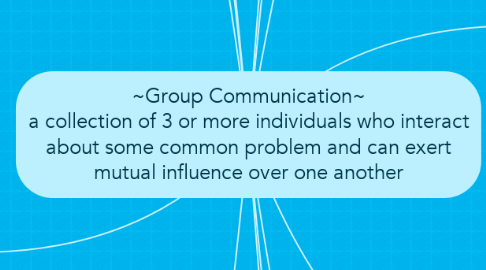
1. Interaction Patterns
1.1. Centralized pattern
1.1.1. One or two people hold the most important positions & most or all of the communication goes through them
1.2. Decentralized pattern
1.2.1. promotes balanced communication
2. Task Leader is the person that keeps the group focused on the primary goal or task by setting agendas, controlling the participation and communication of the group's members, and evaluating ideas and contributions of participants
3. Energizer is the personwho functions as the group’s cheer-leader, providing energy, motivation, and positive encouragement
4. task roles
4.1. Information Gatherers are those people who seek and/or provide the factual information necessary for evaluating ideas, problem solving, and reaching conclusions
4.2. Opinion Gatherers are those that seek out and/or provide subjective responses about ideas and suggestions
4.3. Devil's Advocate is the person that argues a contrary or opposing point of view.
5. forming groups
5.1. forming
5.2. storming
5.3. norming
5.4. performing
5.5. terminating
6. decision making
6.1. To reach consensus group members must participate in the crafting of a decision and agree to adopt it
6.2. voting
6.2.1. by majority may be as simple as having 51% of the vote for a particular decision, or may require a larger percentage, such as two-thirds or three-fourths, before reaching a decision.
6.2.2. compromise - each member gives up something, as well as gains something
6.2.3. authority rule requires essentially no input from the group, although the group's participation may be necessary for implementing the decision.
6.3. Groupthink happens when a group isso focused on agreement and consensus that they do not examine all of the potential solutions available to them
7. groups
7.1. characteristics
7.2. interdependence, interaction, synergy, common goals, shared norms, cohesiveness
7.3. Kinds of Groups
7.3.1. Social Groups
7.3.1.1. tends to be relaxed, informal; interpersonal climate.
7.3.2. Personal Growth Groups
7.3.2.1. dealing with significant issues & problems in a SUPPORTIVE context
7.3.3. Task Groups
7.3.3.1. solves problems
7.4. Effects of group size
7.4.1. Number of people in a group affects the quality of the communication
8. group roles
8.1. social-emotional roles
8.1.1. The Social-Emotional Leader is the person who is concerned with maintaining and balancing the social and emotional needs of the group members and tends to play many, if not all, of the roles in this category.
8.1.2. Encourager practices good listening skills in order to create a safe space for others to share ideas and offer suggestions
8.1.3. Followers are group members that do what they are told, going along with decisions and assignments from the group
8.1.4. Tension Releaser is the person that uses humor, or can skillfully change the subject in an attempt to minimize tension and avoid conflict
8.1.5. Compromiser is the one who mediates disagreements or conflicts among members by encouraging others to give in on small issues for the sake of meeting the goals of the group.
8.2. procedural roles
8.2.1. Facilitator actslike a traffic director by managing the flow of information to keep the group on task.
8.2.2. Gatekeepers are those group members that attempt to maintain proper communicative balance
8.2.3. Recorder is the person responsible for tracking group ideas, decisions, and progress.
8.3. individual roles
8.3.1. Aggressor engages in forceful or dominating communication to put others down or initiate conflict with other members
8.3.2. Blocker is the person that complains or fusses about small procedural matters and often blocks the group from making progress.
8.3.3. Self-Confessor uses the group as a setting to discuss personal or emotional matters not relevant to the group or its task
8.3.4. Playboy or Playgirl shows little interest in the group or the problem at hand and does not contribute in a meaningful way, or at all. This is the person who does essentially no work, yet still gets credit for the group's work
8.3.5. Joker or Clown use inappropriate humor or remarks that can steer the group from its mission.
9. power
9.1. power-over enables one individual or group to make the decisions that affect others and enforce control
9.2. power from within manifests itself when we can stand, walk, and speak words that convey our needs and thoughts
9.3. power-with is the power of a strong individual in a group of equals, the power not to command but to suggest and be listened to, to begin something and see it happen
9.4. Delays
10. cultures
10.1. invidividualistic cultures place high value on the individual person above the needs of the group
10.1.1. Dependencies
10.1.2. Milestones
10.2. Limitations
10.2.1. Schedule
10.2.2. Budget
10.3. collectivist culturesplace high value on group work because they understand that outcomes of our communication impact all members of a community.
10.3.1. KPI's
11. Strengths/Potential limitations
11.1. Strengths
11.1.1. having more resources
11.1.2. more thorough thought
11.1.3. heightened creativity
11.1.4. more commitment
11.2. Potential limitations
11.2.1. Time is required
11.2.2. conformity
11.2.2.1. For example: This can be seen with a person who has credibility.
11.2.3. social loafing: when certain members put less effort than the rest; depends on the size
12. Types of Group Communication
12.1. Task Communication
12.1.1. provides ideas & information, evaluates ideas evaluates understanding
12.2. Procedural Communication
12.2.1. makes group stay organized
12.3. Climate Communication
12.3.1. focuses on creating and maintaining a constructive climate & encourages members to contribute
12.4. Egocentric Communication
12.4.1. dysfunctional communication; blocks others from progressing.
13. Types of Conflicts
13.1. Disruptive Confllict
13.1.1. involves Egocentric communication
13.1.2. is competitive to get their way
13.2. Constructive Conflict
13.2.1. When members understand disagreement are natural & can achieve their share goal
